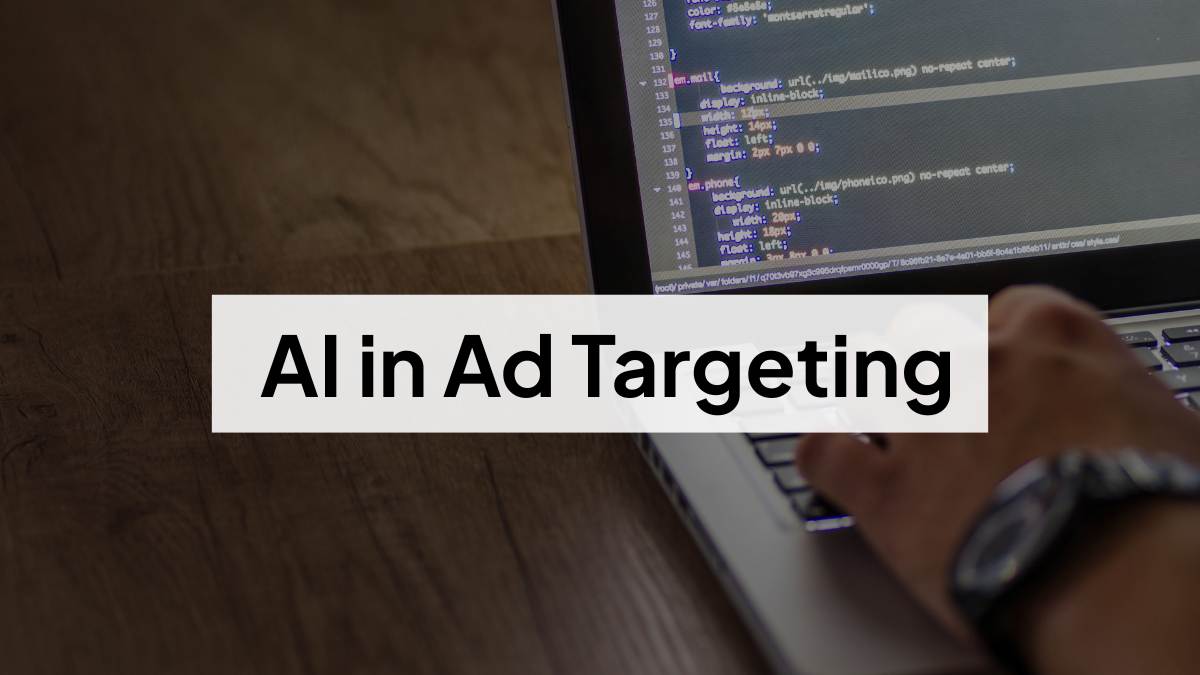AI in ad targeting is quietly reshaping how digital ads actually work. Not in a sci-fi, robot-takes-over kind of way, more like a smart, behind-the-scenes upgrade that most people don’t even notice.
If you’re running ads on platforms like Google, Instagram, or even Spotify, there’s a good chance AI is already playing a role. It sifts through huge amounts of data, figures out what users are likely to engage with, and then serves the right ad, often in just milliseconds.
It’s not flawless, but when it works well, AI in ad targeting can seriously reduce wasted budget and help brands show up in front of the right people at the right time.
Table of Contents
What is AI-Powered Advertising (And Why It Matters Today)?
AI-powered advertising is when machines help you decide who your ads should go to, based on all kinds of data. Instead of just targeting “25 to 35-year-old women in Mumbai,” AI goes deeper. It might notice that a certain type of user scrolls your site late at night, or only buys on weekends, or always adds stuff to cart but never checks out. And it uses that info to guide how your ads are shown.
Compared to the old way? It’s a huge upgrade.
Traditional targeting was… well, kind of basic. You’d pick your audience manually, maybe tweak a few settings, and hope for the best. AI-driven targeting, though, is like having a super-fast assistant that constantly analyzes user behavior and adapts your campaign as it goes.
Most big ad platforms already run on this stuff. Google Ads, Meta (Facebook/Instagram), and Amazon are all leaning hard into machine learning. If you’ve used something like Google’s Performance Max or Meta’s Advantage+, you’ve already seen AI in action. You give it the assets and goals, it handles the rest.
Why does this matter now? Because attention spans are shrinking and ad costs are going up. You really don’t want to waste money showing the wrong ad to the wrong person.
Why Use AI in Ad Targeting?
So yeah, AI can be intimidating. But once you actually see it work, it’s kind of awesome. Here’s what it can help with:
Better Audience Segments
AI doesn’t just throw everyone into buckets like “millennial” or “Gen Z.” It finds smaller patterns, like “people who browse skincare blogs after 10 PM” or “users who only buy during sales.” Stuff a human marketer might not even notice.
More Personal Ad Experiences
Instead of one-size-fits-all ads, AI lets you show different versions to different people. So someone who’s already been to your site might see a reminder ad, while someone brand new might get an intro message.
Smarter Spending
This is a big one. AI helps you stop wasting money. If it sees one version of your ad performing better than the others, it’ll automatically shift budget in that direction.
Faster Results & Optimization
No more waiting weeks to learn what’s working. AI can react in real time. If something’s bombing, it pulls back. If it’s crushing it, it pushes harder. You don’t have to manually adjust bids and placements all day.
Key Components of AI in Advertising
So what’s actually happening behind the scenes? Here’s a quick breakdown (without too much jargon):
- Machine Learning
This is where the system looks at past results, clicks, conversions, bounce rates, and learns what tends to work. It gets smarter over time. - Data Analysis
AI looks at user behavior: what people click, how long they stay on a page, where they’re located, what devices they use, stuff like that. - Smart Algorithms
These decide when, where, and to whom your ad should show. Kind of like automated matchmaking for ads and people. - Automation
Platforms now auto-generate headlines, run A/B tests, and tweak campaigns without you needing to lift a finger. - Personalization Engines
These tools help create customized ads for different people. Amazon’s recommended products or Spotify’s custom playlists? That’s this at work. - Predictive Stuff
AI can even guess what someone might do next, like whether they’re likely to buy or bounce, based on patterns in their behavior.
Examples?
- Meta’s Advantage+ lets you upload a bunch of creatives, and it figures out the best combo to show to each person.
- Google’s Smart Bidding adjusts how much you bid for each impression or click, based on how likely that person is to convert.
You don’t need to understand all the mechanics, but knowing that these tools are built to optimize in real time is pretty valuable.

Enroll Now: AI Marketing Course
How AI Improves Ad Personalization
Okay, so here’s where it gets cool.
AI doesn’t just help you target the right people, it helps you talk to them in the right way. It can adjust headlines, CTAs, even product suggestions based on what that specific person is into.
Let’s say someone’s been browsing sneakers on your website. They leave without buying. AI can serve them a dynamic ad showing the exact shoe they viewed, maybe with a small discount or free shipping. And someone else? They might get an entirely different ad for a new arrival, based on their search habits.
Brands like Spotify do this brilliantly. Their audio ads change depending on what kind of music you’re listening to. It’s not random, it’s customized in real time.
Even smaller brands can use this approach now. Tools like AdCreative.ai make it possible to design ad variations for different customer segments without needing a full creative team.
It’s not just about making ads look good. It’s about making people feel like the ad was meant for them.
The Challenges of AI in Advertising
Now, before we get too hyped, there are some real challenges with AI in ad targeting.
- Privacy is a Big Deal
With rules like GDPR in Europe and Apple’s App Tracking Transparency, a lot of user data is harder to access. That limits how well AI can personalize without crossing any lines.
- Too Much Automation
If you rely completely on AI, you can lose touch with your actual audience. Marketers still need to think critically, AI is a tool, not a replacement.
- The “Black Box” Problem
Sometimes, you don’t know why AI made a decision. You just see the results. That can be frustrating if you need to explain campaign performance to a client or team.
- Bias in the Data
AI learns from data. If that data is flawed or biased, the AI will be too. That’s something marketers really need to keep an eye on.
Also Read: How to Become a Google Ads Specialist
How to Start Using AI in Your Advertising Strategy
Alright. You don’t have to overhaul your entire ad game overnight. If you’re wondering where to even begin with AI in ad targeting, here’s a simple 3-step way to get started. No fancy tech degree required.
1. Audit What You’re Already Using
First, take a look at your current setup. If you’re using Facebook Ads, Google Ads, or Amazon Ads, you’re probably already using AI in some form. Go into your ad account and check what settings you’ve got turned on. Are you letting the platform optimize placements or budgets? Are you using “Smart” campaign types?
Just understanding where AI is already working for you (or not working) is a huge first step.
2. Choose AI-Powered Tools (But Keep It Simple)
You don’t need 12 subscriptions to random AI tools. Start with what’s built into platforms you already use.
- Meta Advantage+: This one’s great for ecommerce. You upload a bunch of creatives and audiences, and it mixes and matches everything automatically to find what works best.
- Google Performance Max: You just give it some creative assets and conversion goals, and it handles the rest, across Search, Display, YouTube, and Gmail.
- AdCreative.ai or Jasper: These can help if you want to speed up ad copy and creative ideas without hiring an entire team.
Test one or two tools. See how they feel. You don’t need to get fancy at first.
3. Test, Learn, and Tweak
The most important part: don’t just “set it and forget it.”
Start with one campaign. Maybe retargeting. Let AI run it, but check in often. What’s working? Which audiences are converting? What ad version is getting clicks?
Use those learnings to improve the next round. Over time, your campaigns will get sharper and more dialed-in.
5 Smart Ways to Use AI in Advertising Right Now
If you’re looking for some fresh ideas to try today, here are a few ways brands (even small ones) are using AI in ad targeting that actually work:
1. Lookalike Audience Modeling
Upload a list of your best customers, and let AI build a new audience that “looks like” them. It’s not just about age or gender, it finds deeper patterns in behavior and interests.
2. Automated Creative Testing
Instead of guessing which ad version will perform better, AI tests dozens (sometimes hundreds) of combinations in real time. It figures out what works faster than a human ever could.
3. Dynamic Ad Personalization
Show different headlines, products, or images to different users, without making 50 versions manually. AI handles the swapping based on who’s viewing it.
4. Smart Retargeting
Forget basic “they visited the site, show them the same ad” retargeting. AI can change messaging based on where someone dropped off. Like, show a cart abandoner a reminder, but show a product page viewer something new.
5. Real-Time Budget Allocation
Let’s say your ad is running on YouTube and Display and Gmail. AI watches where conversions are happening and shifts budget accordingly. That way, you’re not wasting money on underperforming placements.
Real Brand Examples of AI-Powered Ad Targeting
Spotify
Spotify uses AI to create personalized audio ads. Like, if you listen to jazz late at night, you might hear an ad for a chill wine brand around 9 PM. It’s subtle, but super smart. They match ad vibes to your listening habits.
Nike
Nike uses predictive analytics to run local campaigns that push products based on weather and local demand. If it’s raining in Delhi, you might see a campaign for waterproof runners.
(Hypothetical) D2C Skincare Brand
Let’s say a skincare brand uses Meta’s Advantage+ to test five different ad creatives. One talks about oily skin, another about dry skin, one focuses on nighttime routines, and so on. Meta’s AI figures out which version works best for each person and automatically serves the right one. No manual sorting. Just better performance.
Conclusion
In short, AI in ad targeting isn’t some far-off concept – it’s happening right now, across nearly every major ad platform. From smarter audience segments to real-time optimization and personalized creatives, AI is helping brands big and small get more from their ad budgets. And it’s not just about saving time – it’s about making better decisions based on real data. That said, AI isn’t magic. You still need strategy, creativity, and a human understanding of your audience. Think of AI as a powerful assistant, not a replacement. Start small, experiment with tools like Meta Advantage+ or Google Performance Max, and learn as you go. The results can be pretty incredible once it all clicks.
TL;DR – Key Takeaways
- AI in ad targeting helps you reach the right people, at the right time, with the right message.
- Tools like Meta Advantage+ and Google Performance Max use machine learning to optimize ad campaigns automatically.
- Personalized ads powered by AI perform better – higher engagement, more conversions, less wasted spend.
- Small businesses can benefit too – you don’t need a huge team or budget to get started.
- But it’s not “set it and forget it” – human strategy still matters for messaging, brand voice, and ethical targeting.
- Start simple: audit your ad stack, use built-in AI tools, test and learn as you go.
- The future of advertising is already here – and it’s automated, data-driven, and way more efficient.
FAQs: AI in Ad Targeting
Q1: What is AI ad targeting?
It’s when machines (algorithms, really) help figure out who should see your ad, based on data like behavior, interests, location, and more. It makes your ads smarter and usually more effective.
Q2: Can small businesses use AI in their ads?
100% yes. You don’t need a big budget. Meta’s Advantage+ and Google’s Smart Campaigns are built for small teams and still give you AI benefits.
Q3: Will AI replace marketers?
Nope. AI is good at analyzing data and automating stuff, but it still needs a human to guide the strategy, make creative decisions, and understand the big picture.
Q4: What are the best AI tools for ad targeting?
Right now, top picks include Google Performance Max, Meta Advantage+, and tools like AdCreative.ai. But honestly, even using basic features inside Facebook or Google Ads counts.

